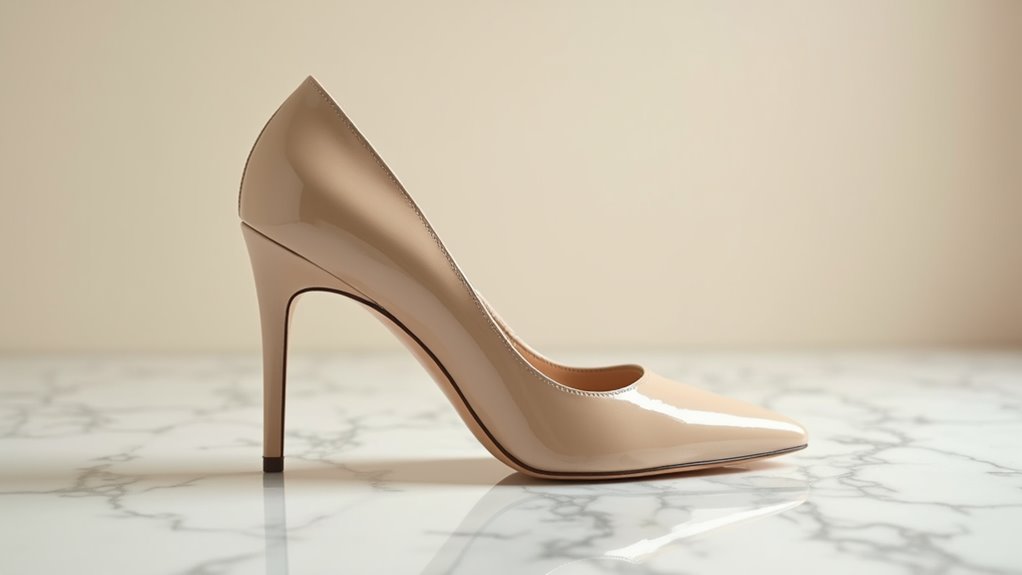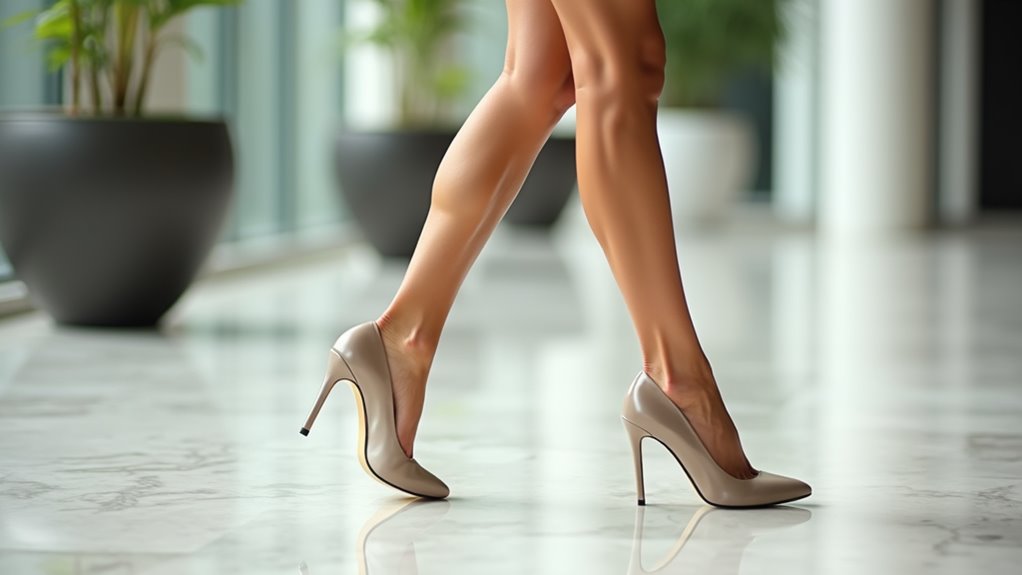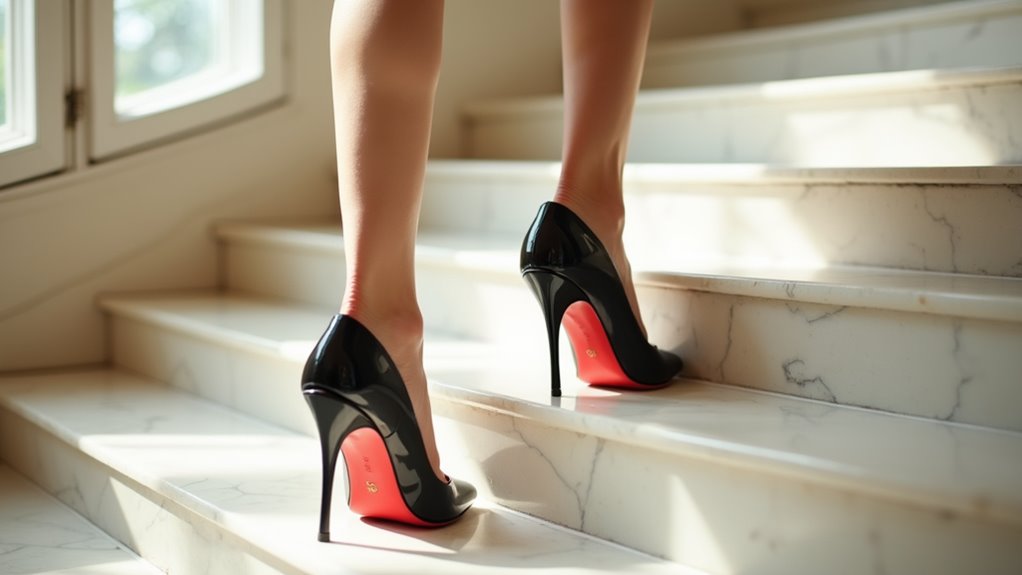There may be products. Products are independently selected by our editors. We may earn an affiliate commission from the links with no charge to you, example: as Amazon Affiliate.
To master walking in heels, we’ll need to focus on proper anatomical alignment and biomechanical efficiency. Let’s start with selecting heels that provide optimal support, ensuring a comfortable toe box and adequate ankle stability. We’ll emphasize a heel-to-toe walking pattern while engaging core muscles to maintain balance. Daily strength training and proprioceptive exercises will enhance stability and prevent injury. Breaking in new footwear gradually on carpeted surfaces helps develop muscle memory and reduces discomfort. For those ready to elevate their heel-wearing expertise, we’ve compiled essential techniques that transform basic steps into confident strides.
Key Takeaways
- Start with 2-3 inch heels and gradually progress to higher heights while mastering proper heel-to-toe walking technique.
- Engage your core muscles and maintain upright posture to distribute weight evenly and enhance stability while walking.
- Practice balance exercises and core strengthening workouts three times weekly to improve stability and confidence in heels.
- Choose anatomically appropriate footwear with adequate toe box space and ankle support for optimal comfort.
- Break in new heels gradually on carpeted surfaces, using thick socks and monitoring pressure points for comfort.
Foundation: Selecting Your Perfect Heels

The foundation of mastering heel-walking begins with selecting anatomically appropriate footwear that aligns with your foot’s biomechanics. We’ll focus on identifying heels that provide optimal comfort and proper support through systematic evaluation of key anatomical pressure points.
When we’re wearing heels, the distribution of body weight shifts significantly, making precise fit paramount. We recommend measuring both foot length and width to ensure proper sizing, as dimensional accuracy directly impacts stability. Let’s start with lower heel heights, typically 2-3 inches, to establish proper muscle memory and gait adaptation. The toe box must accommodate natural foot spread without compression, preventing neurovascular compromise during extended wear.
We emphasize the importance of ankle support through strategic strap placement, which enhances lateral stability and reduces the risk of inversion injuries. Look for padded insoles that cushion metatarsal pressure points, and remember to break them in gradually. We suggest practicing walking in short intervals, increasing duration as muscle adaptation occurs. Through methodical selection and progressive wear, we can optimize both functionality and comfort, ensuring successful integration of heels into daily biomechanical patterns. Consider investing in posture support heels that specifically target proper spinal alignment while walking.
Essential Walking Techniques
Mastering essential walking techniques requires precise biomechanical understanding and deliberate muscular control. We’ll focus on the fundamental heel-to-toe walking pattern, which optimizes weight distribution and minimizes stress on your lower extremities. By maintaining balance through proper alignment, we engage our core muscles while standing tall, creating a stable foundation for movement.
Let’s examine the biomechanics: we’ll take small controlled steps, allowing our body weight to transfer smoothly from heel strike through midfoot to toe-off. This controlled progression helps us maintain elegance and grace while reducing the risk of mechanical instability. We’ll begin by walking on flat surfaces, which allows us to develop proprioceptive awareness and muscular memory before advancing to varied terrain.
To enhance our stability, we’ll choose heels with adequate cushioned insoles, preventing excessive plantar pressure and promoting optimal foot mechanics. As we practice these techniques, our confidence naturally increases through the development of stronger stabilizing muscles and refined motor patterns. Remember, the key to mastery lies in the precise execution of these fundamental movements while maintaining postural integrity throughout your stride. Exploring unique patterned heels can add flair to your walking practice while maintaining proper biomechanics.
Building Strength and Balance

Building optimal stability in heels stems from developing targeted muscular strength and proprioceptive balance. We’ll focus on essential exercises that strengthen core muscles and enhance body awareness to help you master the art of walking in heels with confidence and grace.
| Exercise Type | Primary Benefit | Training Frequency |
|---|---|---|
| Core Work | Postural Stability | 3x Weekly |
| Balance Training | Proprioception | Daily |
| Resistance Band | Ankle Strength | 2x Weekly |
To walk with grace in heels, we must prioritize practicing balance exercises that challenge our proprioceptive system. Single-leg stands and heel-to-toe walks significantly improve neural pathways responsible for maintaining stability. Incorporating yoga or Pilates into your routine enhances flexibility while developing crucial mind-body connections. We recommend progressive training, starting with shorter durations and gradually increasing complexity to build endurance.
When performing these exercises, maintain proper form and focus on engaging your core muscles throughout each movement. This targeted approach develops the muscular strength and balance necessary for confident heel-wearing, while simultaneously reducing the risk of instability-related injuries.
Using quality heel inserts can provide additional support and comfort while practicing these strengthening exercises.
Breaking In New Footwear
Successful acclimation to new heels requires a methodical approach that prioritizes gradual adaptation and proper material conditioning. When breaking in new footwear, we recommend starting with short durations on carpeted surfaces within your home environment. This controlled setting allows us to monitor how your feet respond to the new shoes while minimizing potential discomfort.
We’ve found that wearing thick socks during the initial break-in phase, combined with strategic use of shoe stretchers, helps achieve a customized fit that accommodates your unique foot structure. As you gradually acclimate to wearing high heels, we’ll want you to incrementally increase your wearing time, allowing the anatomical structures of your feet to adapt properly. It’s crucial that we monitor any areas of friction or pressure points, and adjust your wearing time accordingly to avoid pain and potential injury.
For optimal results, we strongly advocate selecting heels with breathable materials and cushioned insoles. These features support the physiological demands placed on your feet during the adaptation process and contribute significantly to long-term comfort. Remember, proper conditioning of new footwear is essential for preventing podiatric complications and ensuring sustainable wear. Choosing shoes with supportive heel design can significantly enhance overall comfort and stability during the breaking-in period.
Common Mistakes to Avoid

While walking in heels can enhance one’s stature and poise, several critical mistakes can compromise both comfort and safety. One of the most common mistakes we observe is the incorrect walking pattern – proceeding from toe to heel instead of the anatomically correct heel-to-toe motion. This improper technique significantly disrupts balance and stability, leading to potential musculoskeletal strain.
We frequently see beginners attempting to master higher heels before establishing proper form with lower heel heights. This premature progression often results in compromised stability and unnecessary discomfort. Additionally, the failure to adequately break in new heels is a critical oversight. We recommend initial wear on carpeted surfaces to gradually acclimate the footwear to your foot’s unique architecture.
Perhaps most concerning is the tendency to ignore foot pain signals, which can lead to chronic injuries and biomechanical issues. Equally important is maintaining proper posture – we notice many individuals slouching, which not only compromises their balance but also diminishes the elegance heels are meant to convey. Remember, optimal heel-wearing technique requires attention to both mechanical precision and postural awareness. For extended wear and maximum comfort, using heel cushion inserts can provide essential support and reduce pressure points.
Conclusion
Walking in heels doesn’t have to be a pain in the neck. We’ve explored the biomechanics, anatomical positioning, and neuromuscular adaptations required for optimal heel-wearing. By implementing these evidence-based techniques – from proper footwear selection to targeted muscle strengthening – we’re now equipped to navigate any terrain with confidence. Let’s apply these clinical principles to transform our gait mechanics and prevent musculoskeletal strain. Remember: practice makes perfect posture.

